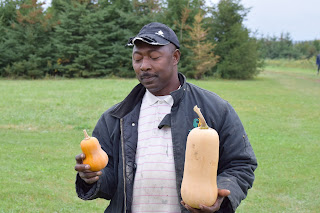"Why can't we drive our cars out to the fields anymore?"
~Question asked at our Pick Your Own from 2012 to the present.
The glory days for the Pick Your Own fruit and vegetable business in Ontario were surely during the 1970's, '80's and '90's.
Families tended to be larger then and we had a committed group of regular customers who picked and preserved large quantities of fresh vegetables. A number of PYO farms flourished in our area to cater to their needs.
In order to accommodate the larger orders, we allowed people to drive their cars out to the fields to pick their own vegetables.
People either kept track of the number of a certain vegetable that they had picked (corn, eggplant or squash) or bushels and baskets were assigned to sell other items by volume (tomatoes, peppers, beans, cucumbers, etc.)
Every morning , beginning at our 8 a.m.opening, I would direct my customers to different fields on the farm. They would return in time with neatly counted bags of corn and level baskets of produce.
It was surely the most simple of business models.
The reality was strikingly different for many reasons, the first being the notion of an 8 a.m..opening. This was like sleeping in until noon for many pickers.
Opening day for squash picking was a case in point. The first customers would arrive in the dark at about 5 a.m, armed with miner's head lights and flashlights. The idea was for the early bird to catch the largest squash, which we sold by the piece, lowering the price as the squash got smaller throughout the day.
One memorable year, it was raining for our squash opening, so I was short staffed (i.e., alone), figuring turnout would be light.
There were seventy cars in the field before our 8 a.m. opening; over one hundred by 9 a.m.
Which prompts a discussion of the second reality of the business: short term memory loss.
The vast majority of our customers were absolutely honest and a pleasure to deal with. There was another group, however that made me feel like the gatekeeper of an early onset farm. The memory of the number of corn and squash in certain customers' car trunks was vague at best and larcenous at worst, which meant that we had to count or measure every piece of produce in the car.
One memorable customer rolled up to our checkout with the front of his clapped out Toyota Corolla inclined at a thirty degree angle and "about five dozen" corn in his trunk. Fifty seven dozen was the final count.
Another woman checked in as a short lady and left two hours later a foot taller than her husband. Further investigation under some suspiciously lumpy seat coverings revealed that all the back car seats had been taken out and replaced with produce.
Her front passenger seat had become a veritable vegetable tower with layer upon layer of produce stowed away. Even her purse was bulging at the seams with shelled Romano beans.
Their guesstimate of "about twenty dollars" worth of vegetables that they did choose to show us in their trunk grew to an actual one hundred and sixty after we had pulled the car apart.
Other customers offered a vegetable medley in their car trunks. These were often big ol' Detroit sedans with massive trunks and large spare tire wells, into which hundreds of pounds of unorganized and uncounted vegetables reposed. Or worse: station wagons and vans.
"Give me a price, Guy!', was the usual request, which is a little like guessing how many dollars worth of guppies are in an aquarium.
Mother Teresa would have been talking to herself after a day of this. Henry Kissinger would have been in therapy.
Certain customers were repeat offenders and clearly loved the cat and mouse game of hiding produce all over the vehicle.
One such customer rolled in early one morning just as it was getting light.
His visit happened to coincide with the rather nasty breakup of our tenants in the house immediately beside the PYO check in.
Long story short: Girl meets guy. Guy goes to Milhaven penitentiary for a year. Guy is released. Girl breaks up with guy who takes it badly. Guy takes girl's SUV out in our fields and runs into every tree and rock he can find. Girl calls police. SWAT team shows up, but guy is gone.
Our customer's visit just happened to coincide with the return of the SWAT team to their vehicles in our parking lot. They were dressed in full on SWAT gear and had many various weapons and riot gear cradled in their arms.
The customer looked at me in alarm and asked, not surprisingly:
"What's going on here?!!."
It was too good an opportunity to pass up. As casually as I could manage, I said:
"Oh, we are
really checking trunks out today!"
It was a fib, of course, but the look of abject horror on his face was so worth it.
He came back an hour later with his vegetables laid out like a church supper.
We still joke about it and, amazingly, he still asks the question at the top of this blog.
Future blog: Pick Your Own Stories 2: Love in a Dangerous Place.
Until then,
Best,
Guy






